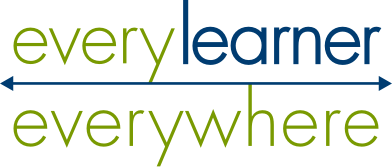Too often when an instructor approaches course design, the question of who they’re designing for comes last, says Tia Holiday, an Instructional Designer and Associate Director at Intentional Futures (Every Learner Everywhere’s strategy partner).
“Instructional design flips that upside down,” she says. “And when you’re designing with equity at the center, you’re really trying to anticipate the unique needs and lived experiences of students.”
Historically, higher education was created with a very white, male, neurotypical, Western framework. Putting students at the heart of course design gives more students the opportunity to succeed, but instructional design that doesn’t actively interrogate assumptions about what kinds of students are in the classroom can reinforce inequalities. Putting equity for minoritized students in particular at the heart of instructional design confronts and tears down specific barriers.
In fact, Holiday and her colleagues at Intentional Futures have been working to identify and embed equity-centered design principles in higher education course design and the selection and implementation of digital learning tools. They define equity-centered design as the practice of purposefully involving minoritized communities throughout a design process with the goal of allowing their voice to directly affect how the solution will address the inequity at hand. Equity-centered design extends the concepts of other human-centered design methodologies by deliberately finding and addressing barriers for minoritized students.
In this article, Holiday shares five practical steps toward implementing equity-centered design.
Look off campus
“Good instructional design is understanding your audience,” says Holiday. “The first thing I ask about when I’m designing a course is where are these students at in the context of their life?”
As an instructor, Holiday notes, you have to remember they have a life outside of your class. When designing the course, it helps to keep in mind that students have competing priorities such as caretaking and employment.
Start by understanding student demographics, including culture, race, gender, sexual orientation, country of origin, first language, economic class, and religion. How do those demographics contribute to their unique sets of needs? How is that likely to affect their prior relationship with the subject matter?
Holiday acknowledges that getting this kind of information about individual students may be difficult for instructors. Historical course-level data from the learning management system can give some insight, along with the data that the institutional research office may be able to provide.
Along with demographics, consider their external obligations. Most students — but particularly racially minoritized students — are juggling multiple roles in their lives alongside this course. They may be a parent, taking care of family at home, or working multiple jobs. An optional survey is one way for instructors to get to know their students better.
Keep in mind that students may not disclose everything about themselves, such as a disability or the situation in their home life.
Learn more: Curricula that Accounts for All Student: A Look at Culturally Responsive Teaching in Higher Ed
Create more options
Holiday recommends instructional designers adhere to basic Universal Design for Learning (UDL) guidelines when designing their courses. That includes providing multiple pathways to learning engagement, providing multiple means of representation, and giving students multiple ways to respond.
UDL guidelines are meant to give students the tools to access the learning goal in a way that’s most effective for them, while also supporting comprehension and empowering them to be better learners.
Holiday notes that providing multiple pathways to learning aimed to support the most in-need students will end up improving learning outcomes for every student. For example, a process for submitting assignments or taking tests that works for students who don’t have personal laptops can benefit their peers also.
Re-examine class policies
Class policies can hide unintended points of friction that exacerbate inequality, so thinking them through carefully is essential.
For example, what questions do you ask in your intro survey, and what does that presuppose about your students? Asking students to choose “male” or “female” automatically tells nonbinary students that they won’t be seen in the curriculum. Asking students to check the box of their ethnicity without inclusive options sends the same message to students: you’re viewing them as categories rather than individuals with complex identities.
“It’s not generally done to cause harm,” says Holiday. “But you already took out trust by the way you phrase those questions.”
Re-consider things like due dates, assignments, and grading rubrics. If only one test attempt is allowed, how does that impact a student who may have a health or family crisis? If assignments are due at six o’clock on Wednesday, how does that impact a student who works full time?
Learn more: What Are Gateway Courses and Why Do They Matter to Equity in Higher Ed?
Ensure access to learning resources
When designing your course, consider the textbooks and materials students will be required to use. Are there more accessible alternatives, or can you provide multiple options for students to choose from?
“A lot of students are choosing between meeting their basic needs and paying for a textbook,” says Holiday. This can be especially true if students are relying on financial aid to pay for textbooks, and they’re waiting for that to come in at the beginning of the course.
This is particularly important with remote learning. Not every student will have access to the same technologies and resources. Provide options to download content rather than assuming students have the bandwidth to stream.
Learn more: Preparing for a Post-COVID Learning Model That Better Serves Disadvantaged Students
Learn from student feedback
Talking to your students will be the best way of knowing whether or not something is working for them, says Holiday. “As humans, it’s really hard to take feedback. But our students just want to succeed. We have to build trust so they can come to us with authentic feedback.”
Build in opportunities throughout the course for students to offer you that feedback so you can continuously improve on the course design. Ask if they liked the assignment, and what barriers they came across in completing the assignment. You can even ask them how they might redesign it.
If you don’t know what would most support your students, says Holiday, you need to go to those students and learn.
Additional resources for equitable instructional design
Every Learner Everywhere’s inclusive design resources toolkit includes strategies and methods for putting equity at the heart of your instructional design.
As you learn more about ensuring equity in instructional design, be aware that you may have to dismantle some of your own ingrained biases. “It’s going to be a personal journey, as well,” Holiday says.



